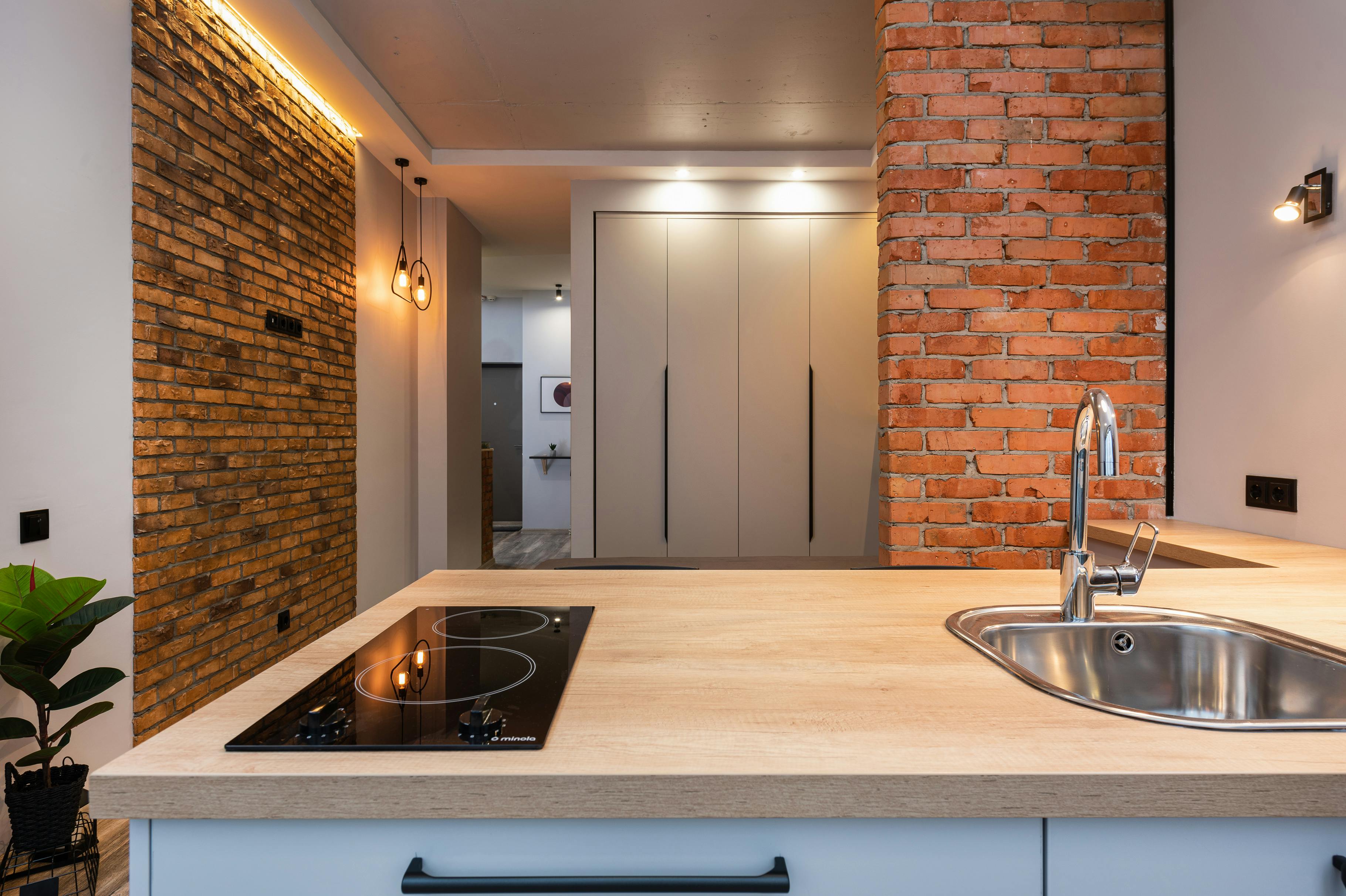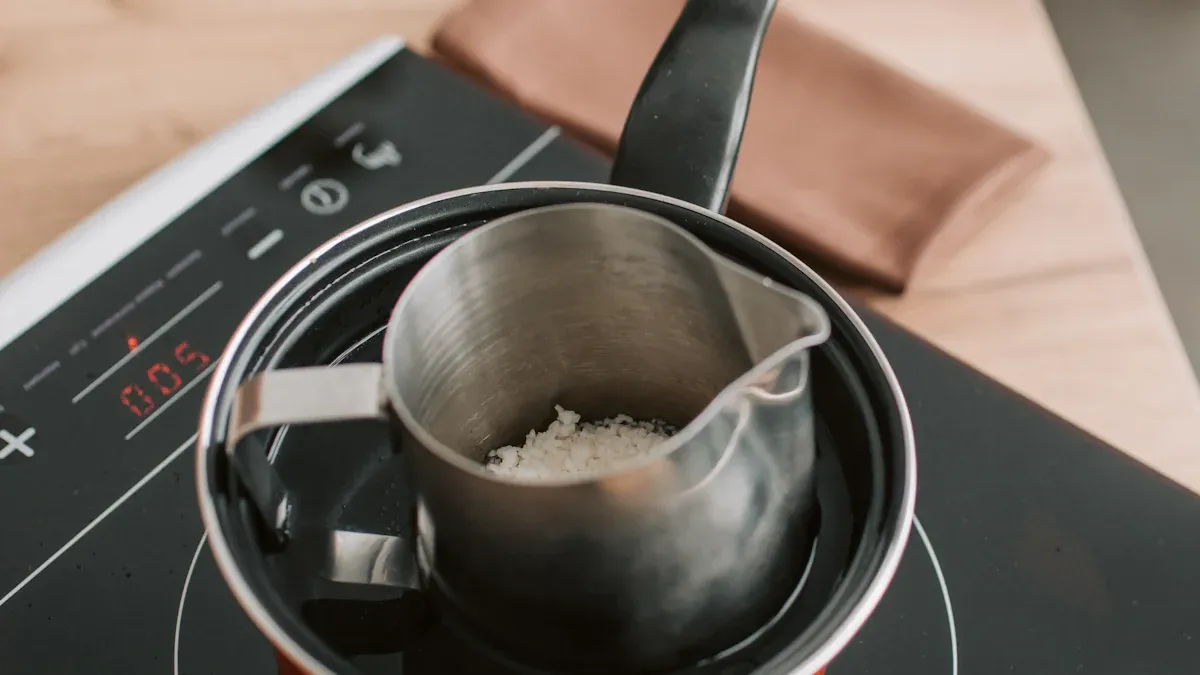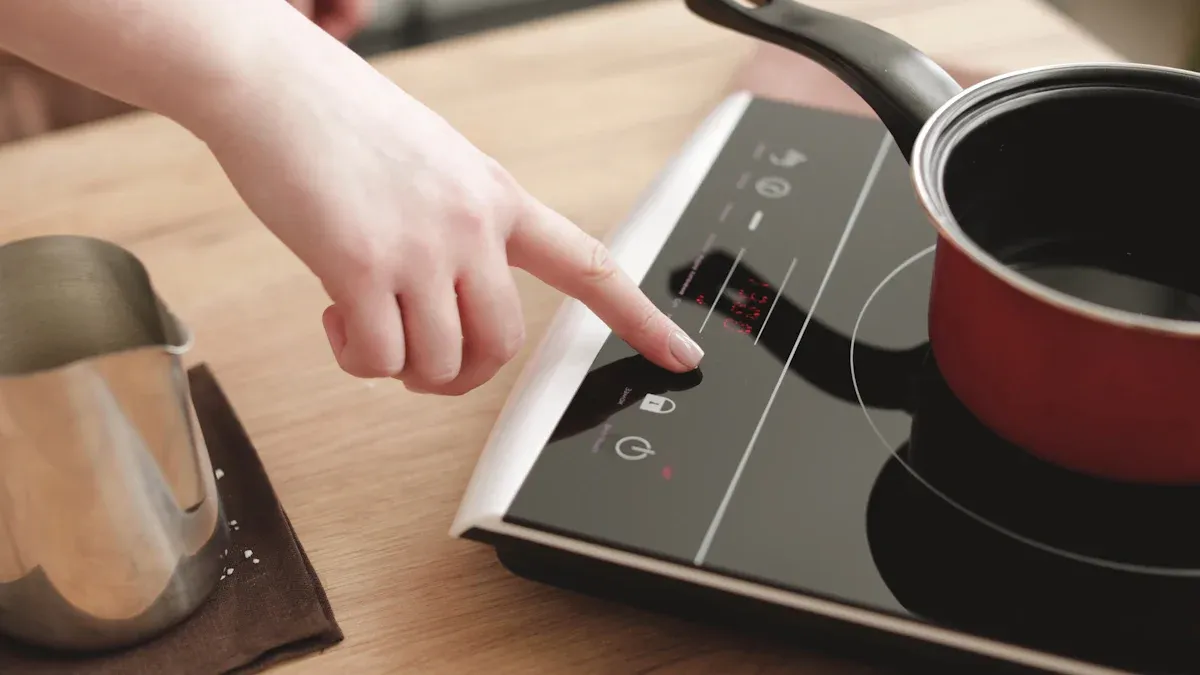How to Safely and Efficiently Use an Induction Cooktop

Learning how to use the induction cooktop isn’t just about convenience—it’s about safety and efficiency too. These cooktops heat quickly and save energy, but they also come with unique considerations. For example, when you use the induction cooktop, it emits EMF radiation, which can pose health risks like sleep issues or even chronic conditions with prolonged exposure. Staying mindful of these risks while cooking ensures a safer experience. Plus, proper use of the induction cooktop helps you save energy and keeps your appliance in top shape. With the right tips for induction cooktop care, you’ll enjoy faster cooking and a cleaner kitchen.
Key Takeaways
Always use pots and pans that work with induction. These are usually made of magnetic materials like stainless steel or cast iron. This helps heat food well and protects your cooktop.
Watch the temperature while cooking so it doesn’t get too hot. Use the controls to change heat levels quickly for better cooking.
Keep lids on pots to save energy and keep heat inside. This helps food cook faster and keeps the temperature steady.
Clean your cooktop after each use to keep it working well. Use soft cleaners and avoid rough tools to stop scratches.
Have a professional install your cooktop. This reduces electrical risks and makes sure it works safely.
Getting Started with Your Induction Cooktop
How to Power On and Set Up
Steps to turn on the induction cooktop
Setting up your induction cooktop for the first time might feel a bit overwhelming, but it’s simpler than you think. Here’s a quick guide to get you started:
Prepare the cutout: Follow the manufacturer’s specifications to create the correct cutout in your countertop.
Protect the edges: Line the edges of the cutout with reflective aluminum tape to prevent heat damage.
Secure the cooktop: Use the supplied brackets or clamps to fasten the cooktop in place.
Connect the power: Call a licensed electrician to connect the power line to the circuit at the junction box. Always ensure the power is off before starting this step.
Once installed, you can turn on the induction cooktop by pressing the power button on the control panel. Most models will light up or display a welcome message, letting you know it’s ready to use.
Understanding the control panel and settings
The control panel is your command center. It typically includes buttons or touch controls for power, temperature adjustment, and cooking modes. Some models even have timers or child-lock features for added safety. Take a moment to familiarize yourself with these controls. If you’re unsure, the user manual is your best friend.
Using Compatible Cookware
Identifying cookware that works with an induction cooktop
Not all pots and pans work with induction cooktops. You’ll need induction-compatible cookware made from ferromagnetic materials like:
Stainless steel (check for low nickel content)
Cast iron
Porcelain enamel on metal (if the base is magnetic)
These materials interact with the magnetic field generated by the cooktop, allowing heat to transfer efficiently.
How to test cookware compatibility
Wondering if your current cookware will work? Here’s a simple test:
If the magnet sticks firmly, the cookware is compatible.
If it clings weakly or doesn’t stick at all, it’s not suitable for induction cooking.
This quick trick can save you from buying unnecessary replacements.
Selecting Cooking Functions
Common cooking modes and their uses
Induction cooktops often come with preset cooking modes like simmer, boil, and sauté. These modes make it easier to prepare specific dishes without constantly adjusting the heat. For example, the simmer mode is perfect for soups, while the boil mode quickly heats water for pasta.
Adjusting heat levels for different recipes
One of the best things about induction cooking is its precise temperature control. You can adjust the heat instantly, which is great for recipes requiring quick changes. For delicate tasks like melting chocolate, use a low setting. For stir-frying, crank it up to high heat. Experiment with these settings to find what works best for your favorite dishes.
Safety Tips for Induction Cooktop Usage

Avoiding Overheating
Monitoring and controlling temperature
When you use the induction cooktop, keeping an eye on the temperature is crucial. Induction cooktops heat up quickly, so it’s easy to overshoot the desired temperature if you’re not careful. Most models come with precise controls, allowing you to adjust the heat instantly. Use these controls to maintain the right temperature for your recipe. For example, start with a lower setting for delicate dishes like sauces and gradually increase as needed. A built-in timer can also help you avoid leaving the cooktop on for too long.
Risks of overheating cookware or the cooktop
Overheating can lead to serious problems. Here’s what could happen:
Excessive heat buildup might ignite nearby materials, such as countertops or cabinets, creating a fire hazard.
Internal components of the induction cooktop, like heating elements, could get damaged. This might result in costly repairs.
Cookware can warp or crack under extreme heat, making it unusable.
In rare cases, overheating may cause thermal runaway, where the temperature spirals out of control.
To avoid these risks, always monitor your cooking and use cookware designed for induction cooktops.
Using Proper Cookware
Importance of flat-bottomed, magnetic cookware
Choosing the right cookware is essential for safe and efficient induction cooktop usage. Flat-bottomed, magnetic cookware ensures even heating and better energy transfer. Materials like stainless steel and cast iron are excellent choices because they interact well with the cooktop’s magnetic field. This not only speeds up cooking but also creates a safer kitchen environment by reducing the risk of uneven heating.
Avoiding incompatible materials
Avoid using cookware made from ceramic, copper, glass, or aluminum. These materials don’t work with induction cooktops and can lead to poor performance or even damage the cooktop. Always check for magnetic properties before using any pot or pan. A quick magnet test can save you from potential issues.
Ensuring Proper Installation
Why professional installation is essential
Proper installation is key to ensuring your induction cooktop operates safely. A professional installer will ensure the electrical connections meet local codes and that the cooktop is securely fitted into the countertop. This minimizes the risk of electrical hazards and keeps your appliance running smoothly.
Checking ventilation and electrical connections
Make sure there’s enough clearance around the cooktop to prevent overheating. Follow these steps for a safe setup:
Ensure there’s adequate space from combustible materials above, below, and on the sides of the cooktop.
Verify that a dedicated, grounded 240-volt circuit is available, protected by the correct breakers.
Prepare the countertop cutout according to the manufacturer’s specifications.
Secure the cooktop in place following the provided instructions.
These steps will help you create a safer kitchen environment and extend the life of your induction cooktop.
Efficient Cooking Practices for an Induction Cooktop
Energy-Saving Techniques
Using the right-sized cookware for the burner
When you use the induction cooktop, matching the cookware size to the burner is essential. Induction cooktops transfer heat directly to the pan, so using a pot that fully covers the burner ensures no energy is wasted. For example, a small pan on a large burner leaves unused space, reducing efficiency. Always check the size of your cookware and align it with the burner for optimal performance.
Retaining heat with lids on pots
Here’s a simple trick to save energy: keep the lid on your pots while cooking. This traps heat inside, allowing food to cook faster and using less energy. Whether you’re boiling water or simmering soup, a lid can make a noticeable difference. Plus, it helps maintain consistent temperatures, which is especially useful for recipes requiring precise heat control.
Proper Temperature Control
Adjusting heat levels for various cooking tasks
Induction cooking gives you precise control over heat levels, making it easier to adjust for different tasks. For example, you can quickly lower the heat to prevent sauces from burning or increase it for a perfect sear on meat. Experiment with the settings to find what works best for your recipes. Familiarizing yourself with these controls will help you cook more efficiently and avoid overcooking or undercooking your meals.
Avoiding energy waste during cooking
Avoiding energy waste is simple with induction cooktops. Start by preheating only when necessary—most induction cooktops heat up so quickly that preheating isn’t always required. Also, turn off the burner a few minutes before your dish is done. The residual heat will finish the cooking process without using extra energy. These small adjustments can make a big difference in your energy consumption.
Preheating and Cooking Times
Benefits of faster heating with induction
Induction cooktops are known for their speed. They can boil water in just 2-3 minutes, compared to 4-5 minutes with gas or electric stoves. This efficiency saves time and energy. Here’s a quick comparison:
Method | Time to Boil Water | Efficiency |
|---|---|---|
Induction Cooktop | 2-3 minutes | 20-40% faster |
Gas and Conventional Electric | 4-5 minutes | Slower |
By heating cookware directly, induction cooktops minimize heat loss, making them about three times more efficient than gas stoves.
Adjusting recipes for quicker cooking
With induction cooking, you’ll need to tweak your recipes to account for faster heating times. Start by preparing all your ingredients before turning on the cooktop. This prevents rushing and mistakes. Also, get comfortable with the controls and experiment with different heat settings. These tips for induction cooktop usage will help you maximize efficiency and enjoy a smoother cooking experience.
How to Clean and Maintain the Induction Cooktop

Cleaning the Induction Cooktop
Recommended cleaning products and tools
To keep your induction cooktop looking and working like new, you’ll need the right tools. Here’s a list of recommended products:
Dishwashing liquid
Spray bottle
Non-abrasive sponge or microfiber cloth
Cooktop scraping tool
Specialized cooktop cleaner (like affresh® cooktop cleaner)
These items are gentle on the surface and effective at removing splatter and residue without causing damage.
Step-by-step guide to cleaning after use
Cleaning your induction cooktop after every use is essential to maintain its efficiency. Follow these step-by-step instructions:
Let the cooktop cool completely.
Scrape off any stuck-on bits with a cooktop scraping tool.
Spray a cleaning solution (dish soap and water or a baking soda-vinegar mix) onto the surface.
Gently scrub with a non-abrasive sponge to remove splatter and residue.
Wipe the surface dry with a microfiber cloth for a streak-free finish.
Repeat the process for stubborn stains, and your cooktop will stay spotless.
Preventing Scratches and Damage
Tips for avoiding scratches on the glass surface
The glass surface of induction cooktops is durable but can scratch if not handled carefully. Use flat-bottomed cookware and avoid dragging pots across the surface. Always lift them instead. Also, steer clear of abrasive cleaning pads or harsh chemicals that could damage the glass.
Handling spills and stains effectively
Spills happen, but cleaning them quickly can prevent long-term damage. Let the cooktop cool before wiping it down. For light messes, use a damp cloth. For tougher stains, apply a non-abrasive cleanser and gently scrub. Avoid using sharp tools or petrol-based products, as they can harm the surface.
Maintenance Tips
Regular checks for wear and tear
Regular maintenance helps you properly care for your induction cooktop. Inspect the surface for cracks or scratches and check the ventilation holes to ensure they’re not blocked. Keeping the cooktop dry and free from spills also prevents water damage.
When to call for professional servicing
If you notice unusual behavior, like inconsistent heating or error messages, it’s time to call a professional. They can inspect the electrical components and ensure everything is functioning correctly. Regular servicing extends the life of your cooktop and keeps it running efficiently.
Pro Tip: Cleaning and maintaining your induction cooktop regularly prevents residue buildup, enhances its longevity, and keeps it looking brand new.
Using an induction cooktop can transform your cooking experience when you follow the right steps. Start with proper setup and compatible cookware to ensure safety and efficiency. Take advantage of rapid heating and precise temperature control for better results. Always monitor for splatter and clean up residue to maintain your cooktop’s performance. Don’t forget regular maintenance to properly care for your appliance. By following these tips for induction cooktop usage, you’ll enjoy faster, safer, and more efficient cooking every day.
FAQ
What should you do if food splatter burns onto the induction cooktop?
Let the cooktop cool completely. Then, use a cooktop scraper to gently remove the splatter. Apply a cleaning solution and wipe it with a non-abrasive sponge. Finish by drying the surface with a microfiber cloth to avoid streaks.
Tip: Cleaning spills immediately prevents stubborn residue buildup.
Can you use regular cookware on induction cooktops?
No, regular cookware may not work. Induction cooktops require magnetic cookware like stainless steel or cast iron. Use a magnet to test compatibility. If it sticks firmly to the bottom of the pan, it’s good to go.
How often should you clean your induction cooktop?
You should clean it after every use. Wipe away spills and splatter immediately to prevent residue buildup. For deeper cleaning, use a specialized cooktop cleaner weekly to maintain its shine and efficiency.
Why does your induction cooktop make a buzzing noise?
The buzzing sound is normal. It happens when the magnetic field interacts with the cookware. Thinner pans or high heat settings can amplify the noise. Switching to thicker cookware often reduces it.
What’s the best way to avoid scratches on the cooktop?
Always lift cookware instead of dragging it. Use flat-bottomed pots and pans. Avoid abrasive cleaning pads or harsh chemicals. These simple steps help keep the glass surface scratch-free.
See Also
Key Guidelines for Using Portable Induction Cooktops Effectively
Three Important Tips for Choosing a Two Burner Induction Cooktop
Discover How Induction Cooktops Are More Energy Efficient
The Environmental Benefits of Using Electric Induction Cooktops
Comparing Portable Induction Cooktops and Traditional Options for You

